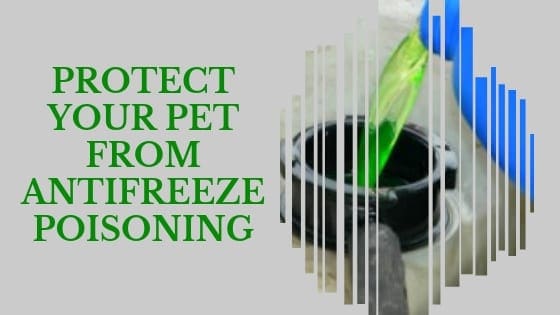
Antifreeze (ethylene glycol) is a product added to car windshield wiper reservoirs and in car radiators to prevent freezing. Antifreeze poisoning occurs when pets lick or drink any of the substance that may have spilled or leaked onto driveways, garage floors or parking lots. You can usually recognize it by the bright green color.
While it may not seem logical that a pet would want to lick a chemical substance, antifreeze actually has a sweet taste. Dogs are a bit more at risk because cats don’t generally have a sweet tooth, but if outdoor water sources have frozen over, a pet may resort to drinking from a puddle of antifreeze. Cats who have acquired a sweet tooth from being fed table food will also be at higher risk.
A small amount of antifreeze is all it takes to cause poisoning and the substance is absorbed rapidly by the body.
Signs of Poisoning
A common sign of antifreeze poisoning is that your pet will appear drunk and perhaps have a wobbly gait. There may also be rapid breathing, depression, twitching muscles, diarrhea and increased thirst and increased urination.
There are three stages of antifreeze poisoning:
Stage 1 About 30 minutes to 12 hours after ingestion. Signs may include:
- vomiting
- Increased thirst and increased urination
- Wobbly gait
- Seizure
- rapid eye movement
- Muscle twitching
- cat appears drunk
- low body temperature
Stage 2: 12 to 24 hours after ingestion:
- rapid heart rate
- rapid breathing
- symptoms usually disappear which may lead cat owners to believe the cat is better but the poison is advancing toward kidney failure at this point
Stage 3: 12-24 hours after ingestion:
- Drooling
- vomiting
- diarrhea
- severe depression
- possible coma
- Kidney failure
- Death may occur
First Aid
The most important step is to get to the veterinarian right away. If poisoning occurs during off-hours and your veterinary clinic doesn’t have emergency services, know where an emergency clinic is located or another veterinary clinic that does have off-hours emergency care. Get to the veterinarian immediately because if treated soon after ingestion, it may prevent kidney damage. The cat must be treated within a couple of hours of ingestion. Contact your veterinarian if you suspect your cat has ingested even the smallest amount of antifreeze. If you can’t reach any veterinarian and have no emergency clinic nearby, contact ASPCA Animal Poison Control at (888) 426-4435, 24 hours a day, 365 days a year. A consultation fee may apply.
Prevention
Keep all antifreeze in sealed containers and wipe up any drips running down the sides. When refilling your car with antifreeze, make sure your pets are kept away. Clean up all spills and don’t leave containers with the caps off, even for a short time because it doesn’t take much to poison a small animal. You can recognize antifreeze by its bright green color. After cleaning any spills or leaks, dilute any residue, using a hose or a bucket of water. Routinely check for leaks from vehicles and get them repaired immediately.
There are some “safer” antifreeze products available made of propylene glycol instead of the toxic ethylene glycol. Higher amounts of propylene glycol must be ingested to be toxic. Check labels before purchasing to ensure you have the safer product. Regardless of what product you choose, wipe up all spills and drips, routinely check for leaks under your car and keep all antifreeze completely stored safely away.
Make sure outdoor pets have access to water sources that aren’t frozen to reduce the chances that they’ll ingest antifreeze as a substitute.
The safest option is, in my opinion, to keep cats indoors. Supervise your dog when outdoors and if you walk your dog on a leash, be aware that puddles may contain antifreeze.
Need More Information?
For more information on cat behavior and training, check out the best-selling books by Pam Johnson-Bennett. Pam’s books are available at bookstores and online. We’ve included Amazon links here on our website.
Note: This article is not intended as a replacement for medical care. If you suspect your cat has ingested antifreeze, seek immediate veterinary care.



